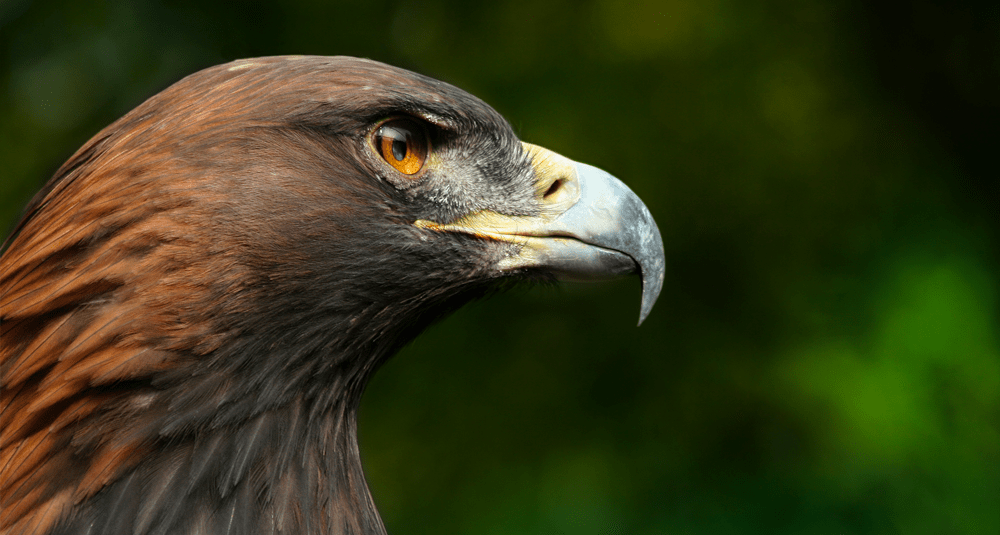To which family of birds does the golden eagle belong?
Last Updated:
The golden eagle (Aquila chrysaetos) is a large bird of prey, famous for its imposing wingspan, which can reach 2.3 meters. Its predominantly dark brown plumage, with golden hues on the head and neck, gives it a majestic and distinctive allure.
These physical characteristics, combined with its upright posture and piercing gaze, have helped to give it iconic status in many cultures. In Native American traditions, for example, it is often regarded as a symbol of power and freedom, and its feathers are used in various rituals and ornaments.
To differentiate the golden eagle from other eagles, it is essential to consider aspects such as size, hunting behavior and habitat. While eagles in general are characterized by their large size and hunting skills, the golden eagle is distinguished by its preference for a variety of habitats, from rocky mountains to open forests, as well as by its unique hunting techniques, which most often involve high-altitude flight followed by a rapid dive to capture its prey.
Classified in the Accipitridae family, the golden eagle shares this category with other birds of prey such as buzzards, falcons and certain vultures.
Members of this family are characterized by strong, curved talons, a hooked beak adapted to tearing flesh and excellent vision – essential attributes for predators at the top of the food chain. These birds are also known for their remarkable flying abilities, using thermal currents to glide with minimum effort.
Within the Accipitridae family, there is a wide variety of species, each adapted to specific environments. For example, the bald eagle, emblematic of the United States, prefers habitats close to water, while hawks are often found in forests and wooded areas.
The golden eagle’s range is vast, covering North America, Eurasia and North Africa. They are highly adaptable and can reside in a wide variety of habitats, from rocky mountains to open forests to semi-desert regions.
Their choice of habitat reflects their hunting and nesting needs. They prefer places with wide, unobstructed views to spot their prey, and cliffs or tall trees to build their nests.
The golden eagle impresses with its size, with a wingspan of up to 2.3 meters and a weight of up to 6.5 kg for females, who are generally larger than males. Their plumage is dark brown, with distinctive golden highlights on their head and neck. They have very fine vision, enabling them to spot their prey at great distances.
The golden eagle’s diet is varied, but consists mainly of small to medium-sized mammals such as hares and marmots, and occasionally larger animals such as young deer. It also feeds on birds, reptiles and fish.
The golden eagle uses its keen vision to spot prey at a distance, then makes a swift, precise descent to capture it with its powerful talons. This efficient hunting method reflects its role as a supreme predator in its ecosystem.
The golden eagle’s reproductive cycle begins with the construction of a nest, usually on cliffs or in tall trees. These nests, often reused and enlarged each year, can reach impressive dimensions.
Breeding begins in spring, when the pair generally lays from one to four eggs. Both parents share responsibility for incubation, which lasts around 45 days.
After hatching, care of the young is intensive. The parents actively hunt to feed their hungry offspring, who leave the nest after around 3 months, although they remain dependent on their parents for hunting for several more months. Golden eagles can live up to 20 years in the wild, and even longer in captivity.
The golden eagle is currently classified as a species of least concern by the International Union for Conservation of Nature (IUCN), although it is more threatened in some regions.
The main threats to this species are habitat loss due to human development, direct persecution and, in some areas, collisions with infrastructure such as wind turbines.
Conservation efforts focus on habitat protection, public awareness and population monitoring to preserve this iconic species.
The golden eagle has long held an important place in cultures around the world, often symbolizing power and freedom. In some cultures, it is revered as a link between the spiritual and physical worlds.
However, the impact of human activity on the golden eagle is twofold. On the one hand, habitat loss and hunting have endangered them in some regions. On the other hand, conservation initiatives and increased awareness have stabilized and even boosted some populations.
nature

To which family of birds does the golden eagle belong?
Answer
The golden eagle is a member of the Accipitridae, a family of birds of prey that also includes harriers, vultures and falcons.